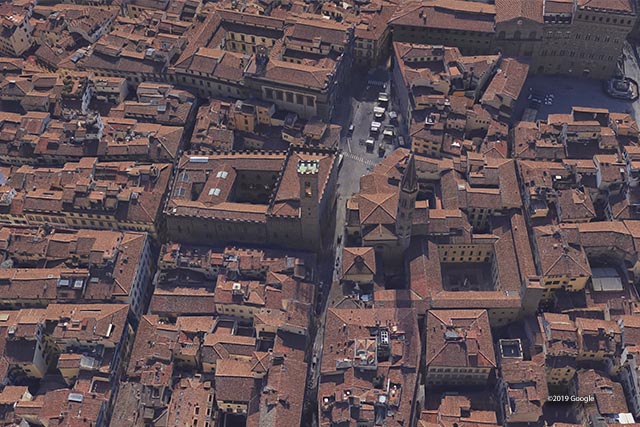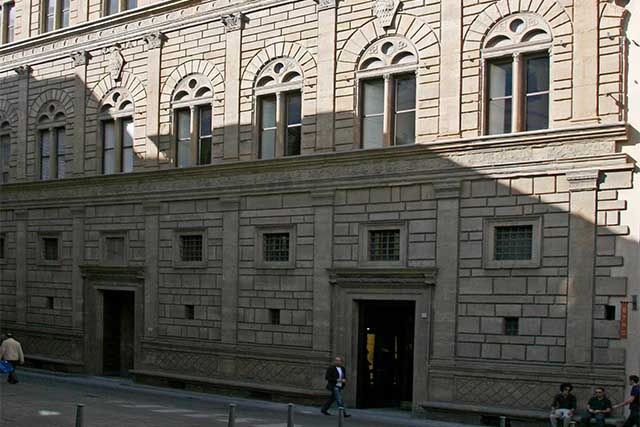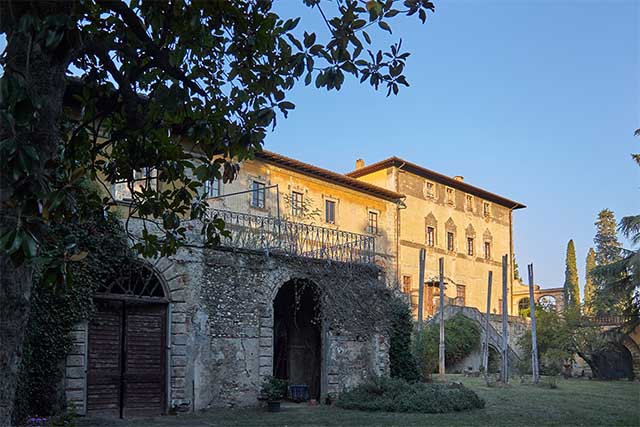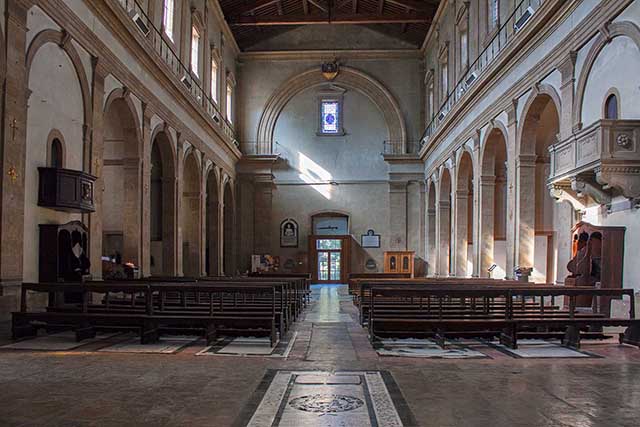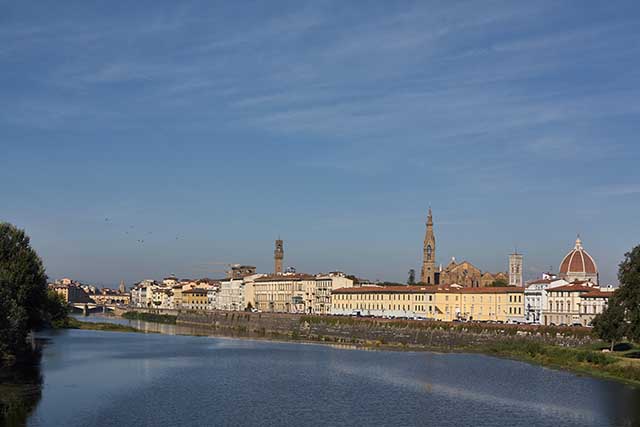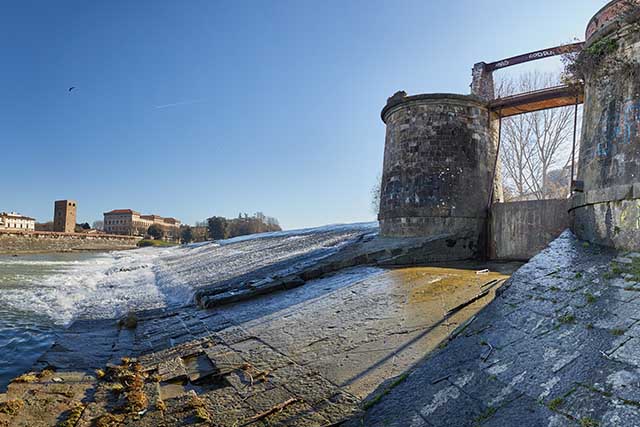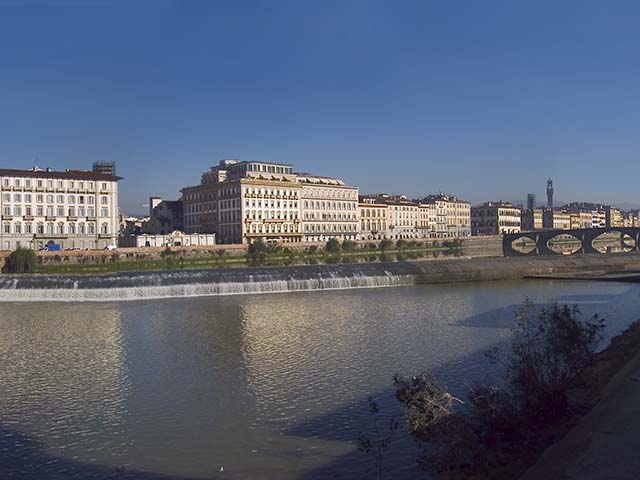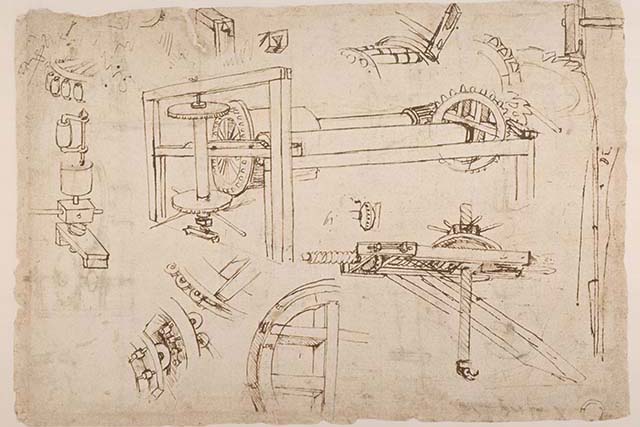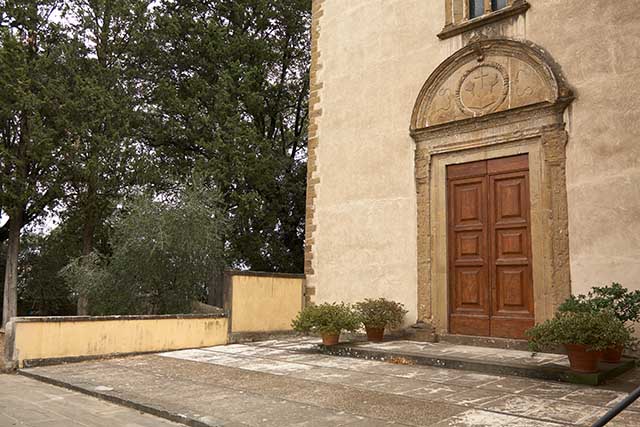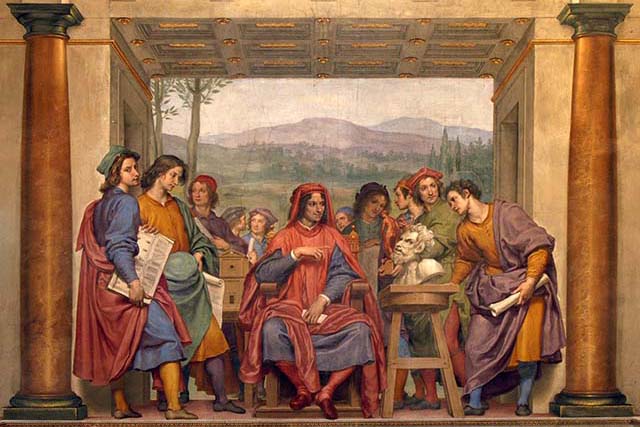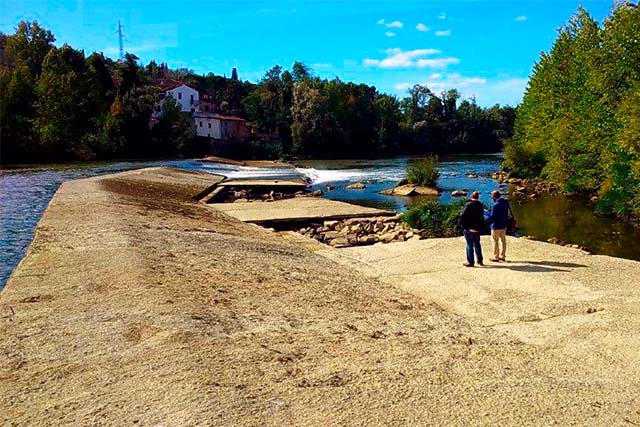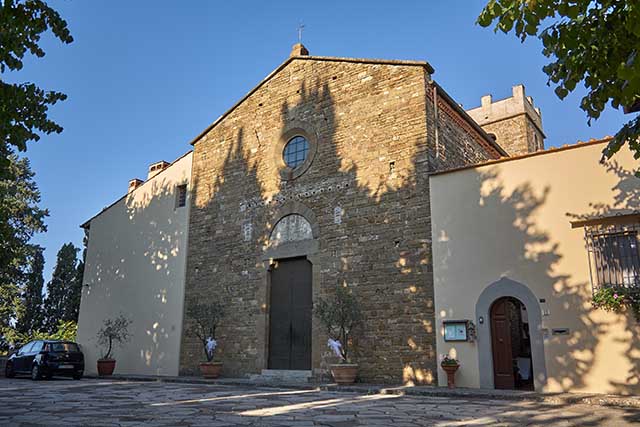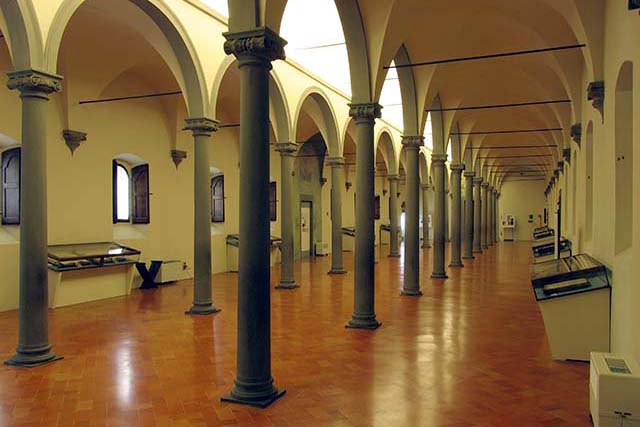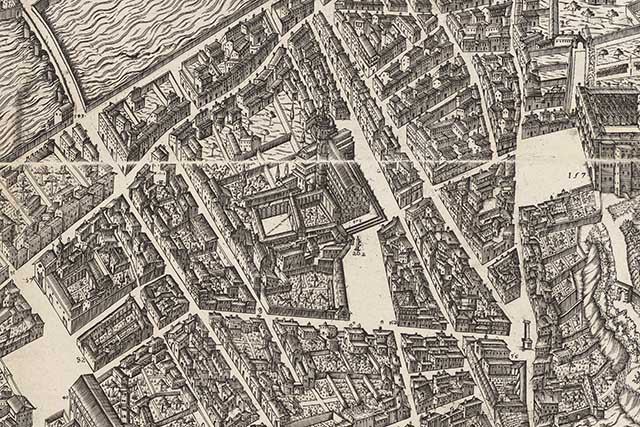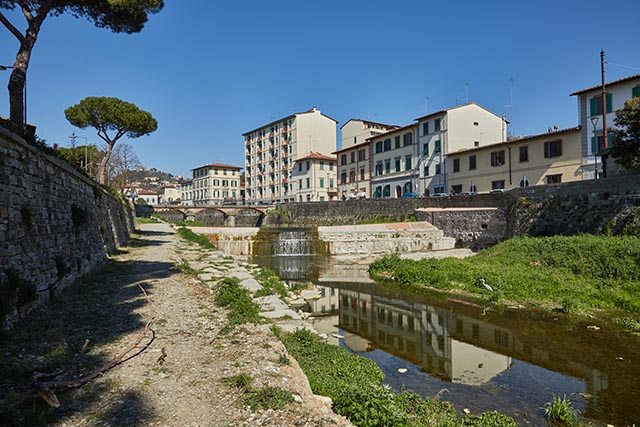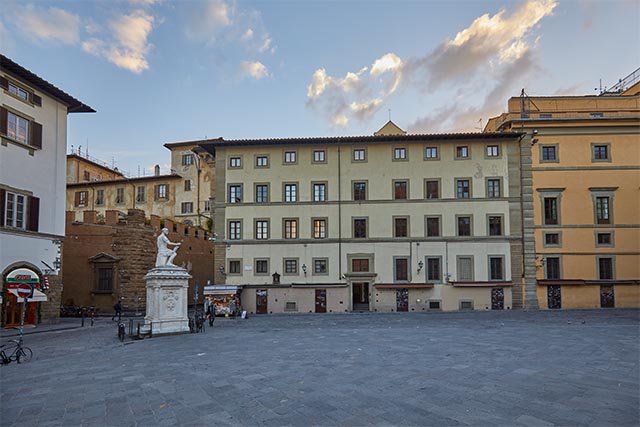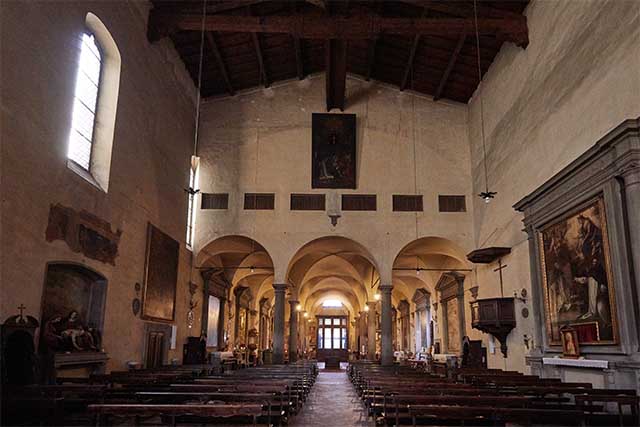Municipality of Florence
Ser Piero practiced the profession of notary in Florence from 1448 to 1504. When he died, on July 9, 1504, Leonardo noted that he was still «notary at Palazzo del Podestà» (today's Bargello Museum), in the vicinity of which he had his studio, alone or in partnership with other notaries. When he died his place was taken by his son, Ser Giuliano Da Vinci.
This important Florentine family intermarried with the Medici was on friendly terms with Leonardo's father. The renowned Palazzo Rucellai was built in the mid-fifteenth century by Bernardo Rossellino to the design of Alberti inspired the architecture of some of the most important Florentine palaces. The only hydraulic device designed by Leonardo whose invention is documented is the water meter said to have been sent by him from France to Bernardo Rucellai.
Rusciano and Il Paradiso are two localities are situated on the left bank of the Arno. Rusciano is mentioned more than once in Leonardo’s papers and gives its name to the villa that was built in the area. Del Paradiso is a hill at whose base lies a monastic complex that was built around an imposing, pre-existing building. Il Paradiso became a favourite meeting place for leading figures in the early period of Florentine humanism.
Returning to Florence in the year 1500, Leonardo was consulted in regard to the new bell tower of San Miniato and the static problems of the church of San Salvatore al Monte. In the Strozzi Papers in the Florence State Archive we can read the opinion of Leonardo. In the Codex Arundel, Leonardo had been concerned with the breakage of the walls and their repair. In regard to the lantern on the Milan Cathedral, he had already noted in the Codex Atlanticus the similarity between the physician and the architect: Leonardo considered buildings, in fact, to be living organisms having need, when "ill", of an "architect/physician".
The route is delineated by information taken from map RL 12679 (Windsor Castle), also keeping in mind map RL 12680, the Codex Leicester, the Codex Arundel and Ms. L. This ideal walk along the ancient banks of the Arno can start from the plain of Ripoli (from "ripe", i.e., rive [banks] of the Arno), traversed in Roman times by the Via Cassia, which was described by Repetti in the 19th century as follows: «The plain, or rather the garden, most delightful, most fruitful, most flowery, most populated with villas, palaces, churches and habitations, among those that form a garland around beautiful Florence».
We enter Florence, starting the second route based on the map of the bridges in the Codex Arundel and the map of Florence RL 12681 (Windsor Castle). Leonardo specifies (in Ms. L) that the distance «from the Arno wall of Giustizia to the Arno bank of Sardigna, where there are the mulberry trees at the mill is 7400 braccia, that is, 2 miles and 1400 braccia (on the right bank)» and «on the other side of the Arno it is 5500 braccia» (on the left bank), but the difference of 1900 braccia given by Leonardo (equivalent to about 1,107 metres) seems not to match the actual distance between the points indicated.
The third part of the Arno itinerary is based on maps RL 12678 (Windsor Castle), considering also RL 12677, folios 148v, 149r, 273r and 275v of the Codex Arundel and 15A-15r of the Codex Leicester. Leonardo calculates that from "point S" (the confluence of the two branches of the Arno at Peretola) to the Ognissanti weir (in proximity to the "Sardigna") «is 5000 bracci, that is, a mile and 2/3" (around 3,000 metres)». On the folios of the Codex Arundel, in addition to measuring the course and the banks of the Arno and the Mugnone, Leonardo takes an interest in the hydraulic system and characteristics of the mills and fulling mills on the right bank ("8 and 2 millstones") and on the left bank ("2 millstones"), as well as the relationship between the city's walls and the river.
As is evident from several drawings and sketches, the Cathedral of Florence, and Brunelleschi's Dome in particular, were fundamental to Leonard's formation especially as regards knowledge of the principles of church architecture and the operation of construction site machines.
Mount Oliveto is a hill lying just outside the historic city gate of San Frediano. In 1472 the church of San Bartolomeo and its monastery were enlarged and renovated in the Renaissance style. The church was decorated with an Annunciation by Leonardo, which in 1867 was moved to the Uffizi. A Last Supper by Sodoma, a follower of Leonardo, is still conserved there.
Leonardo was not yet twenty years of age when he collaborated with his teacher Verrocchio in the realization of the great copper sphere that was destined to be placed atop the dome of the Cathedral of Florence on 27 May 1471. This memorable event was recorded by Luca Landucci in his Diario Fiorentino. In a note dating to around 1515 Leonardo himself recalled that he had witnessed the soldering of the sphere.
The Anonymous Gaddiano writes that Leonardo «stayed as a young man with the Magnificent Lorenzo de’ Medici, who provided for him and had him work for him in the garden on Piazza di San Marco in Florence». The "Garden of Lorenzo" was situated at the corner of Piazza San Marco between today's Via Cavour and Via Arazzieri. Vasari recalls the presence in the garden of artists close to Leonardo, such as Rustici, Lorenzo di Credi, as well as Baccio da Montelupo and Andrea Sansovino. When Charles VIII entered Florence in 1494, determining the flight of the Medici, the Garden was sacked by the enraged populace.
The course of the Arno was always of great interest to Leonardo da Vinci who studied and described it several times. Today the Arno offers many areas of great historical, environmental and naturalistic interest.
A sketch of the hills lying to the south of the Arno River can be found on a folio from the Codex Madrid II. Leonardo depicts what today would be referred to as the skyline with, for example, the hill known as Mount Oliveto on which still stands the Church of San Bartolomeo a Monte Oliveto (once part of a monastery complex situated alongside what is now the park belonging to the Villa Strozzi). The Bellosguardo Tower (which is perfectly recognizable in the drawing) and the Church of Santa Margherita a Montici have also survived to this day.
The architect Michelozzo designed this elegant hall with its three naves on the commission of Cosimo the Elder in 1437. It is considered to be the first public library in Europe. Leonardo mentions it in the Codex Atlanticus (toward 1480) and in the Codex Arundel (ca. 1505).
Forming part of the Monastery of the Holy Spirit was not only the celebrated Basilica di Santo Spirito designed by Brunelleschi, but also a library with a significant collection of manuscripts. The church is decorated with many paintings by contemporaries of Leonardo who were greatly influenced by his work. Leonardo mentions the library in an annotation dating to around 1505 in the Codex Atlanticus.
Of the waterways of the Florentine plain the Mugnone is one of the most important. Its course, in great part walkable, has been modified several times as the city has expanded until settling in its current course. Cited often by Leonardo da Vinci, its course is seen clearly in the various maps he made and in several texts.
In 1515 Pope Leo X stayed in Florence: the city held extraordinary festivities in his honour. Some of the greatest artists of the time collaborated on the scenography and organisation of the event. At this time there arose the idea of rearranging the section of Florence between Piazza San Marco and Piazza San Lorenzo. Leonardo worked on a project consisting of several parts, including the following initiatives: constructing a Medici Palace, opposite that of Cosimo the Elder; demolishing the Church of San Giovannino and rebuilding it in front of the new Medici Palace; providing a facade for San Lorenzo and enlarging the square in front of it; a new arrangement of the San Marco area.
Among the famous protagonists of the Florentine Renaissance, some showed interest in the problems of theatrical scenography . Memorable, in fact, were the theatrical/technical sets designed by Brunelleschi for some of the Florentine churches. Undoubtedly, Leonardo had in mind these elaborate theatrical sets when he designed the complex mechanical devices for the staging of Bernardo Bellincioni's Paradise Festival, presented in Milan in 1490. Sophisticated mechanisms operated by counter-weights were used for Poliziano's Orpheus, whose stage sets included a "mountain that opens" from which emerged Pluto.





